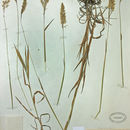Associations
provided by BioImages, the virtual fieldguide, UK
In Great Britain and/or Ireland:
Foodplant / parasite
Blumeria graminis parasitises live Holcus mollis
Foodplant / spot causer
amphigenous acervulus of Colletotrichum coelomycetous anamorph of Colletotrichum holci causes spots on fading leaf of Holcus mollis
Remarks: season: 7-8
Foodplant / parasite
sorus of Entyloma dactylidis parasitises live leaf of Holcus mollis
Other: major host/prey
Foodplant / gall
stroma of Epichlo causes gall of stem of Holcus mollis
Foodplant / saprobe
fruitbody of Marasmius curreyi is saprobic on dead, decayed stem of Holcus mollis
Other: major host/prey
Foodplant / parasite
amphigenous, scattered or in patches uredium of Puccinia coronata parasitises live leaf of Holcus mollis
Remarks: season: summer
Foodplant / parasite
telium of Puccinia hordei parasitises live stem of Holcus mollis
Other: minor host/prey
Foodplant / spot causer
deeply immersed, very minute, hardly visible, black pycnidium of Septoria coelomycetous anamorph of Septoria holci causes spots on fading leaf of Holcus mollis
Remarks: season: 8
Foodplant / pathogen
embedded sorus of Tilletia holci infects and damages ovary of Holcus mollis
Remarks: season: 6-9
Foodplant / spot causer
long, linear, erumpent sorus of Ustilago striiformis causes spots on live, blistered leaf of Holcus mollis
Other: major host/prey
Comprehensive Description
provided by North American Flora
Holcus mollis L. Syst. Nat. ed. 10. 2: 1305. 1759
Aira mollis Schreb. Spic. Fl. Lips. 51. 1771. (Ba,sed on Holcus mollis L.)
Aira holcus-mollis Vill. Hist. PI. Dauph. 2: 88. 1787. (Based on Holcus mollis L.)
/Irena sy/uo/ica Salisb. Prodr. 24. 1796. (Kased on Holcus mollis h.)
Avena mollis Kokqt, Ucscr. Gram. 300. 1802. (Based on Holcus mollis L.) Not /I. moHii Salisb.,
1796. Ginannia mollis Bubani, Fl. Pyren. 4: 321. 1901. (Based on Holcus mollis L.) Notholcus mollis Hitchc. Am. jour. Bot. 2: 304. 1915. (Based on Holcus mollis L.)
Culms ascending, 50-100 cm. tall, leafy below, with vigorous slender rhizomes; sheaths, except the lower, glabrous; ligule membranaceous, about 2 mm. long; blades from rather harshly velvety on both surfaces to glabrcsccnt-scabrous, obscurely while-margined, mostly 6-13 cm. long, 4-10 mm. wide; panicle ovate to narrowly oblong, dense to rather loose, 6-10 cm. long; spikelets 4-5 ram. long; glumes subequal, acuminate, scabrous, hirsute on the nerve;, the second broader than the first; lemmas pubescent on the callus and on the back toward the summit, about 2,5 mm. long, the second with a geniculate awn 3-4 mm. long; paleas thin, nearly as long as their lemmas.
Type locality: Europe.
Distribution: Damp places, recently introduced and apparently spreading, Lewis County, New York; ballast, Catnden. New Jersey; Washington to California; native of Europe.
- bibliographic citation
- Albert Spear Hitchcock, Jason Richard Swallen, Agnes Chase. 1939. (POALES); POACEAE (pars). North American flora. vol 17(8). New York Botanical Garden, New York, NY
Physical Description
provided by USDA PLANTS text
Perennials, Terrestrial, not aquatic, Rhizomes present, Rhizome elongate, creeping, stems distant, Stolons or runners present, Stems nodes swollen or brittle, Stems erect or ascending, Stems geniculate, decumbent, or lax, sometimes rooting at nodes, Stems caespitose, tufted, or clustered, Stems terete, round in cross section, or polygonal, Stem nodes bearded or hairy, Stem internodes hollow, Stems with inflorescence less than 1 m tall, Stems with inflorescence 1-2 m tall, Stems, culms, or scapes exceeding basal leaves, Leaves mostly cauline, Leaves conspicuously 2-ranked, disticho us, Leaves sheathing at base, Leaf sheath mostly open, or loose, Leaf sheath hairy, hispid or prickly, Leaf sheath and blade differentiated, Leaf blades linear, Leaf blades lanceolate, Leaf blades 2-10 mm wide, Leaf blades 1-2 cm wide, Leaf blades mostly flat, Leaf blade margins folded, involute, or conduplicate, Leaf blades mostly glabrous, Leaf blades more or less hairy, Ligule present, Ligule an unfringed eciliate membrane, Ligule a fringed, ciliate, or lobed membrane, Inflorescence terminal, Inflorescence an open panicle, openly paniculate, branches spreading, Inflorescence solitary, with 1 spike, fascicle, glomerule, head, or cluster per stem or culm, Flowers bisexual, Spikelets pedicellate, Spikelets laterally compressed, Spikelet less than 3 mm wide, Spikelets with 1 fertile floret, Spikelets with 2 florets, Spikelets solitary at rachis nodes, Spikelets all alike and fertille, Spikelets bisexual, Spikelets disarticulating below the glumes, Rachilla or pedicel glabrous , Glumes present, empty bracts, Glumes 2 clearly present, Glumes equal or subequal, Glumes equal to or longer than adjacent lemma, Glume equal to or longer than spikelet, Glumes keeled or winged, Glumes 1 nerved, Glumes 3 nerved, Lemma coriaceous, firmer or thicker in texture than the glumes, Lemma 5-7 nerved, Lemma glabrous, Lemma apex truncate, rounded, or obtuse, Lemma distinctly awned, more than 2-3 mm, Lemma with 1 awn, Lemma awn less than 1 cm long, Lemma awn subapical or dorsal, Lemma awn once geniculate, bent once, Lemma margins thin, lying flat, Lemma straight, Palea present, well developed, Palea about equal to lemma, Palea 2 nerved or 2 keeled, Stamens 3, Styles 2-fid, deeply 2-branched, Stigmas 2, Fruit - caryopsis.

